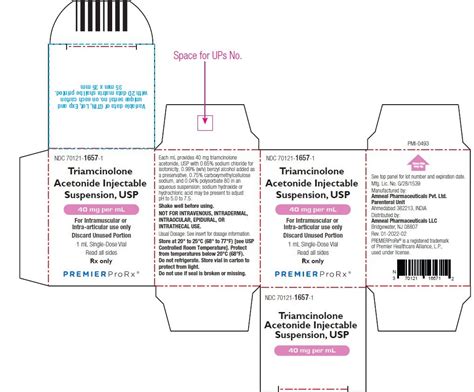Intro
Discover the potential Triamcinolone side effects, including skin thinning, mood changes, and adrenal suppression, and learn how to manage risks associated with this corticosteroid medication, minimizing adverse reactions and ensuring safe treatment outcomes.
The use of triamcinolone, a synthetic corticosteroid, has become increasingly prevalent in the treatment of various medical conditions, including skin disorders, allergies, and respiratory issues. While this medication can provide significant relief and improvement in symptoms, it is essential to be aware of the potential triamcinolone side effects that may arise. Understanding these side effects is crucial for patients to make informed decisions about their treatment and to minimize the risk of adverse reactions.
Triamcinolone is a potent anti-inflammatory agent that works by suppressing the immune system's response to inflammation. This can lead to a range of benefits, including reduced swelling, redness, and pain. However, the suppression of the immune system can also increase the risk of infections and other complications. Furthermore, the long-term use of triamcinolone can lead to a range of systemic side effects, including changes in mood, appetite, and sleep patterns.
The importance of understanding triamcinolone side effects cannot be overstated. By being aware of the potential risks and benefits associated with this medication, patients can take steps to minimize their exposure to adverse reactions. This may involve working closely with their healthcare provider to monitor their condition, adjusting their dosage or treatment regimen as needed, and taking proactive steps to manage any side effects that arise. In this article, we will delve into the various triamcinolone side effects, exploring their causes, symptoms, and management strategies.
Common Triamcinolone Side Effects

Injection Site Reactions
Injection site reactions are among the most common triamcinolone side effects. These reactions can range from mild to severe and may include symptoms such as redness, swelling, pain, and bruising. In some cases, patients may experience more severe reactions, including infection, abscess formation, or nerve damage. To minimize the risk of injection site reactions, it is essential to follow proper injection techniques and to rotate injection sites regularly.Systemic Triamcinolone Side Effects

Adrenal Insufficiency
Adrenal insufficiency is a rare but potentially life-threatening triamcinolone side effect. This condition occurs when the adrenal glands are unable to produce sufficient cortisol, a hormone that plays a critical role in regulating blood pressure, blood sugar levels, and electrolyte balance. Adrenal insufficiency can cause a range of symptoms, including fatigue, weakness, weight loss, and low blood pressure. To minimize the risk of adrenal insufficiency, it is essential to use triamcinolone at the lowest effective dose and for the shortest duration necessary.Long-Term Triamcinolone Side Effects

Osteoporosis
Osteoporosis is a common long-term triamcinolone side effect. This condition occurs when the bones become weak and brittle, increasing the risk of fractures and osteoporotic compression. Osteoporosis can be managed through a range of strategies, including calcium and vitamin D supplements, bisphosphonates, and lifestyle modifications. To minimize the risk of osteoporosis, it is essential to maintain a healthy diet, exercise regularly, and avoid smoking and excessive alcohol consumption.Managing Triamcinolone Side Effects

Lifestyle Modifications
Lifestyle modifications can play a critical role in managing triamcinolone side effects. This may involve maintaining a healthy diet, exercising regularly, and avoiding smoking and excessive alcohol consumption. Patients should also aim to get enough sleep, manage stress, and engage in activities that promote relaxation and well-being. By making these lifestyle modifications, patients can reduce their risk of adverse reactions and improve their overall health and well-being.Conclusion and Future Directions

Final Thoughts

What are the most common triamcinolone side effects?
+The most common triamcinolone side effects include injection site reactions, changes in mood, appetite, and sleep patterns, as well as gastrointestinal side effects such as nausea, vomiting, and diarrhea.
How can I minimize the risk of triamcinolone side effects?
+To minimize the risk of triamcinolone side effects, it is essential to use the medication at the lowest effective dose and for the shortest duration necessary. Patients should also follow proper injection techniques, rotate injection sites regularly, and implement lifestyle modifications to promote overall health and well-being.
What are the long-term triamcinolone side effects?
+The long-term use of triamcinolone can lead to a range of side effects, including osteoporosis, cataracts, and glaucoma. Patients should be monitored regularly for these side effects and take proactive steps to manage them, such as maintaining a healthy diet, exercising regularly, and avoiding smoking and excessive alcohol consumption.
We invite you to share your thoughts and experiences with triamcinolone side effects in the comments section below. Your input can help others better understand the potential risks and benefits associated with this medication and make informed decisions about their treatment. Additionally, we encourage you to share this article with others who may be interested in learning more about triamcinolone side effects and how to manage them. By working together, we can promote greater awareness and understanding of this important topic and improve patient outcomes.
